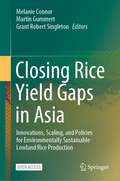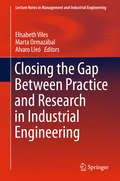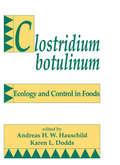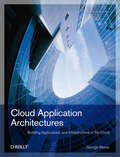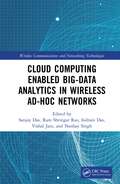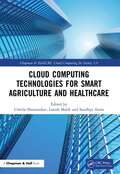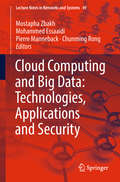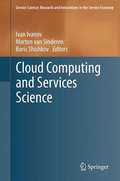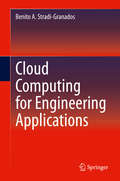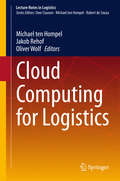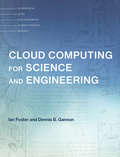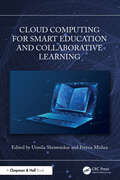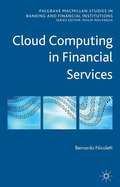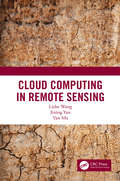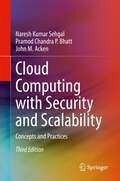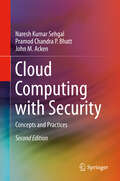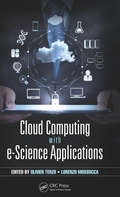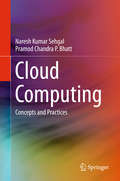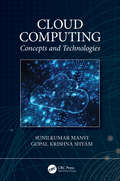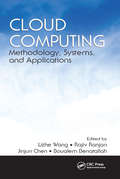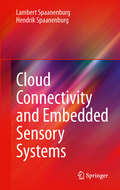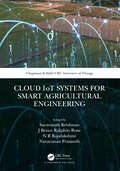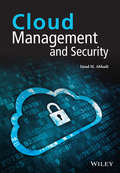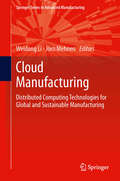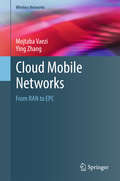- Table View
- List View
Closing Rice Yield Gaps in Asia: Innovations, Scaling, and Policies for Environmentally Sustainable Lowland Rice Production
by Martin Gummert Melanie Connor Grant Robert SingletonThis open access book contributes not only to the scientific literature on sustainable agricultural development and in particular rice agriculture but also is highly valuable to assist practitioners, projects, and policymakers due to its sections on reducing carbon footprint, agricultural innovations, and lessons learned from a multi-country/multi-stages development project. The scope of the book is conceived as a detailed documentation of the implementation, dissemination, and impact of the CORIGAP project in Sri Lanka, Myanmar, Thailand, China, Vietnam, and Indonesia, with spill-over to Cambodia and the Philippines. It pulls together actionable research findings with the experience of bringing these findings into use. The aim of the book is to provide a wide array of pathways to impact for sustainable rice production in lowland irrigated rice-based agricultural systems. The book is written by local actors of the rice value chain, researchers, and engineers working on a range of best management practices, climate-smart rice production innovations, knowledge translation, and dissemination, as well as decision-making and policy aspects. It is envisioned that the contents of the book can be translated into messages that can help farmers, extension workers, policymakers, and funders of agricultural development, decide on implementing best management practices and climate-smart technologies in their agroecological systems by presenting the technological/practical options along the rice value chain and the partnerships and business models required for their implementation. The book is aimed at practitioners, extension specialists, researchers, and engineers interested in information on current best management practices, sustainable, and climate-smart rice production and constraints that need further investigation. Furthermore, the book is also aimed at policymakers and agricultural development funders required by public opinion and legally binding agreements to reduce greenhouse gas emissions, conserve biodiversity and increase agroecological practices, who are looking for research-based evidence to guide policymaking and implementation.
Closing the Gap Between Practice and Research in Industrial Engineering (Lecture Notes in Management and Industrial Engineering)
by Elisabeth Viles Marta Ormazábal Alvaro LleóThis book presents the proceedings of the XXII International Conference on Industrial Engineering and Operations Management, International IIE Conference 2016, and International AIM Conference 2016. This joint conference is a result of an agreement between ADINGOR (Asociaci#65533;n para el Desarrollo de la Ingenier#65533;a de Organizaci#65533;n), ABEPRO (Associa#65533;#65533;o Brasileira de Engenharia de Produ#65533;#65533;o), AIM (European Academy for Industrial Management) and the IIE (Institute of Industrial Engineers), and took place at TECNUN-School of Engineering (San Sebasti#65533;n, Spain) from July 13th to 15th, 2016. The book includes the latest research advances and cutting-edge analyses of real case studies in Industrial Engineering and Operations Management from diverse international contexts, while also identifying concrete business applications for the latest findings and innovations in operations management and the decisions sciences.
Clostridium Botulinum: Ecology and Control in Foods (Food Science And Technology Ser. #54)
by HauschildAn in-depth resource addressing the ecology of Clostridium botulinum which affects the degree of food contamination, and its control in various foods. The text summarizes worldwide data on this organism in food and the environment and the principles of its control in specific foods and products.
Cloud Application Architectures: Building Applications and Infrastructure in the Cloud (Theory in Practice (O'Reilly))
by George ReeseIf you're involved in planning IT infrastructure as a network or system architect, system administrator, or developer, this book will help you adapt your skills to work with these highly scalable, highly redundant infrastructure services. While analysts hotly debate the advantages and risks of cloud computing, IT staff and programmers are left to determine whether and how to put their applications into these virtualized services. Cloud Application Architectures provides answers -- and critical guidance -- on issues of cost, availability, performance, scaling, privacy, and security. With Cloud Application Architectures, you will:Understand the differences between traditional deployment and cloud computingDetermine whether moving existing applications to the cloud makes technical and business senseAnalyze and compare the long-term costs of cloud services, traditional hosting, and owning dedicated serversLearn how to build a transactional web application for the cloud or migrate one to itUnderstand how the cloud helps you better prepare for disaster recoveryChange your perspective on application scalingTo provide realistic examples of the book's principles in action, the author delves into some of the choices and operations available on Amazon Web Services, and includes high-level summaries of several of the other services available on the market today. Cloud Application Architectures provides best practices that apply to every available cloud service. Learn how to make the transition to the cloud and prepare your web applications to succeed.
Cloud Computing Enabled Big-Data Analytics in Wireless Ad-hoc Networks (Wireless Communications and Networking Technologies)
by Sanjoy DasThis book discusses intelligent computing through Internet of Things (IoT) and Big Data in vehicular environments in a single volume. It covers important topics, such as topology-based routing protocols, heterogeneous wireless networks, security risks, software-defined vehicular ad-hoc networks, vehicular delay tolerant networks, and energy harvesting for WSNs using rectenna. Features Covers applications of IoT in Vehicular Ad-hoc Network (VANETs) Discusses use of machine learning and other computing techniques for enhancing performance of networks Explains game theory-based vertical handoffs in heterogeneous wireless networks Examines monitoring and surveillance of vehicles through the vehicular sensor network Investigates theoretical approaches on software-defined VANET The book is aimed at graduate students and academic researchers in the fields of electrical engineering, electronics and communication engineering, computer science, and engineering.
Cloud Computing Technologies for Smart Agriculture and Healthcare (Chapman & Hall/CRC Cloud Computing for Society 5.0)
by Urmila ShrawankarThe Cloud is an advanced and fast-growing technology in the current era. The computing paradigm has changed drastically. It provided a new insight into the computing world with new characteristics including on-demand, virtualization, scalability and many more. Utility computing, virtualization and service-oriented architecture (SoA) are the key characteristics of Cloud computing. The Cloud provides distinct IT services over the web on a pay-as-you-go and on-demand basis. Cloud Computing Technologies for Smart Agriculture and Healthcare covers Cloud management and its framework. It also focuses how the Cloud computing framework can be integrated with applications based on agriculture and healthcare. Features: Contains a systematic overview of the state-of-the-art, basic theories, challenges, implementation, and case studies on Cloud technology Discusses of recent research results and future advancement in virtualization technology Focuses on core theories, architectures, and technologies necessary to develop and understand the computing models and its applications Includes a wide range of examples that uses Cloud technology for increasing farm profitability and sustainable production Presents the farming industry with Cloud technology that allows it toaggregate, analyze, and share data across farms and the world Includes Cloud-based electronic health records with privacy and security features Offers suitable IT solutions to the global issues in the domain of agriculture and health care for society This reference book is aimed at undergraduate and post-graduate programs. It will also help research scholars in their research work. This book also benefits like scientists, business innovators, entrepreneurs, professionals, and practitioners.
Cloud Computing and Big Data: Technologies, Applications and Security (Lecture Notes in Networks and Systems #49)
by Mostapha Zbakh Mohammed Essaaidi Pierre Manneback Chunming RongThis book addresses topics related to cloud and Big Data technologies, architecture and applications including distributed computing and data centers, cloud infrastructure and security, and end-user services. The majority of the book is devoted to the security aspects of cloud computing and Big Data. Cloud computing, which can be seen as any subscription-based or pay-per-use service that extends the Internet’s existing capabilities, has gained considerable attention from both academia and the IT industry as a new infrastructure requiring smaller investments in hardware platforms, staff training, or licensing software tools. It is a new paradigm that has ushered in a revolution in both data storage and computation. In parallel to this progress, Big Data technologies, which rely heavily on cloud computing platforms for both data storage and processing, have been developed and deployed at breathtaking speed. They are among the most frequently used technologies for developing applications and services in many fields, such as the web, health, and energy. Accordingly, cloud computing and Big Data technologies are two of the most central current and future research mainstreams. They involve and impact a host of fields, including business, scientific research, and public and private administration. Gathering extended versions of the best papers presented at the Third International Conference on Cloud Computing Technologies and Applications (CloudTech’17), this book offers a valuable resource for all Information System managers, researchers, students, developers, and policymakers involved in the technological and application aspects of cloud computing and Big Data.
Cloud Computing and Services Science: Second International Conference, Closer 2012, Porto, Portugal, April 18-21, 2012. Revised Selected Papers (Service Science: Research and Innovations in the Service Economy #367)
by Boris Shishkov Marten Van Sinderen Ivan IvanovThe Cloud Computing and Services Science book comprises a collection of the best papers presented at the International Conference on Cloud Computing and Services Science (CLOSER), which was held in The Netherlands in May 2011. In netting papers from the conference researchers and experts from all over the world explore a wide-ranging variety of the emerging Cloud Computing platforms, models, applications and enabling technologies. Further, in several papers the authors exemplify essential links to Services Science as service development abstraction, service innovation, and service engineering, acknowledging the service-orientation in most current IT-driven structures in the Cloud. The Cloud Computing and Services Science book is organized around important dimensions of technology trends in the domain of cloud computing in relation to a broad scientific understanding of modern services emerging from services science. The papers of this book are inspired by scholarly and practical work on the latest advances related to cloud infrastructure, operations, security, services, and management through the global network. This book includes several features that will be helpful, interesting, and inspirational to students, researchers as well as practitioners. Professionals and decision makers working in this field will also benefit from this book
Cloud Computing for Engineering Applications
by Benito A. Stradi-GranadosThis book explains the use of cloud computing systems for engineering applications to satisfy the need for enterprise level, state-of-the-art computational capacities at an affordable cost. As huge costs are involved in the maintenance and timely renovation of computational capabilities, particularly for projects that require significant computational capacity, cloud services can achieve considerable savings for users and organizations engaged in engineering research and development. Dr. Stradi-Granados explains how to extract a maximum value from every dollar invested in cloud computer server. The types of facilities located around the world that lease their resources to customers interested in reducing the internal overhead and implementation time. The volume features chapters on model generation, motion studies, and prototyping is ideal for students, researchers, practitioners, and facility's managers across a range of engineering domains.
Cloud Computing for Logistics (Lecture Notes in Logistics)
by Michael Hompel Jakob Rehof Oliver WolfThis edited monograph brings together research papers covering the state of the art in cloud computing for logistics. The book includes general business object models for intralogistics as well as user-friendly methods for logistics business process design. It also presents a general template for logistics applications from the cloud. The target audience primarily comprises researchers and experts in the field, but the book will also be beneficial for graduate students.
Cloud Computing for Science and Engineering (Scientific and Engineering Computation)
by Ian Foster Dennis B. GannonA guide to cloud computing for students, scientists, and engineers, with advice and many hands-on examples.The emergence of powerful, always-on cloud utilities has transformed how consumers interact with information technology, enabling video streaming, intelligent personal assistants, and the sharing of content. Businesses, too, have benefited from the cloud, outsourcing much of their information technology to cloud services. Science, however, has not fully exploited the advantages of the cloud. Could scientific discovery be accelerated if mundane chores were automated and outsourced to the cloud? Leading computer scientists Ian Foster and Dennis Gannon argue that it can, and in this book offer a guide to cloud computing for students, scientists, and engineers, with advice and many hands-on examples. The book surveys the technology that underpins the cloud, new approaches to technical problems enabled by the cloud, and the concepts required to integrate cloud services into scientific work. It covers managing data in the cloud, and how to program these services; computing in the cloud, from deploying single virtual machines or containers to supporting basic interactive science experiments to gathering clusters of machines to do data analytics; using the cloud as a platform for automating analysis procedures, machine learning, and analyzing streaming data; building your own cloud with open source software; and cloud security.The book is accompanied by a website, Cloud4SciEng.org, that provides a variety of supplementary material, including exercises, lecture slides, and other resources helpful to readers and instructors.
Cloud Computing for Smart Education and Collaborative Learning
by Urmila Shrawankar Prerna MishraThe book presents next-generation education technology and the pedagogy of the Education Cloud. It covers technological developments, case studies, innovative research approaches, and solutions for advanced learning paradigms using Internet of Things (IoT), cloud computing, and machine learning to handle various challenges of the smart education system. It discusses cloud architecture, management, and frame- work for education from virtual classrooms and labs. It shows how cloud computing framework can be integrated with fog computing, edge computing, deep learning, and IoT. Illustrates from fundamental theories to practical and sophisticated applications of cloud technology for the education domain Explores e-learning applications through location-independent cloud services to reduce cost Covers result-oriented, real-time solutions for smart, accessible education and its real-time application support Discusses accessible cloud services for people with special needs Presents flexible and scalable cost-effective e-learning architecture and scenario for education technology It serves as a valuable resource for academicians, researchers, and professionals interested in smart education and cloud technology.
Cloud Computing in Financial Services
by Bernardo NicolettiFinancial institutions must become more innovative in the conduct of their business. Cloud computing helps to achieve several objectives: innovative services, re-engineered processes, business agility and value optimization. Research, consultancy practice and case studies in this book consider the opportunities and risks with vendor relationships.
Cloud Computing in Remote Sensing
by Lizhe Wang Yan Ma Jining YanThis book provides the users with quick and easy data acquisition, processing, storage and product generation services. It describes the entire life cycle of remote sensing data and builds an entire high performance remote sensing data processing system framework. It also develops a series of remote sensing data management and processing standards. Features: Covers remote sensing cloud computing Covers remote sensing data integration across distributed data centers Covers cloud storage based remote sensing data share service Covers high performance remote sensing data processing Covers distributed remote sensing products analysis
Cloud Computing with Security and Scalability.: Concepts and Practices
by Naresh Kumar Sehgal Pramod Chandra Bhatt John M. AckenThis book provides readers with an overview of Cloud Computing, starting with historical background on mainframe computers and early networking protocols, leading to current concerns such as hardware and systems security, performance, emerging areas of IoT, Edge Computing, and healthcare etc. Readers will benefit from the in-depth discussion of cloud computing usage and the underlying architectures. The authors explain carefully the “why’s and how’s” of Cloud Computing, so engineers will find this book an invaluable source of information to the topic. This third edition includes new material on Cloud Computing Scalability, as well as best practices for using dynamic cloud infrastructure, and cloud operations management with cost optimizations. Several new examples and analysis of cloud security have been added, including ARM architecture and https protocol.Provides practical guidance for software developers engaged in migrating in-house applications to Public Cloud;Describes for IT managers how to improve their Cloud Computing infrastructures;Includes coverage of security concerns with Cloud operating models;Uses several case studies to illustrate the “why’s and how’s” of using the Cloud;Examples and options to improve Cloud Computing Scalability.
Cloud Computing with Security: Concepts and Practices
by Naresh Kumar Sehgal Pramod Chandra Bhatt John M. AckenThis book provides readers with an overview of Cloud Computing, starting with historical background on mainframe computers and early networking protocols, leading to current concerns such as hardware and systems security, performance, emerging areas of IoT, Edge Computing etc. Readers will benefit from the in-depth discussion of cloud computing usage and the underlying architectures. The authors explain carefully the “why’s and how’s” of Cloud Computing, so engineers will find this book an invaluable source of information to the topic. This second edition includes new material on Cloud Computing Security, Threat Vectors and Trust Models, as well as best practices for a using dynamic cloud infrastructure, and cloud operations management. Several new examples and analysis of cloud security have been added, including edge computing with IoT devices.
Cloud Computing with e-Science Applications
by Olivier Terzo Lorenzo MossuccaThe amount of data in everyday life has been exploding. This data increase has been especially significant in scientific fields, where substantial amounts of data must be captured, communicated, aggregated, stored, and analyzed. Cloud Computing with e-Science Applications explains how cloud computing can improve data management in data-heavy fields such as bioinformatics, earth science, and computer science. The book begins with an overview of cloud models supplied by the National Institute of Standards and Technology (NIST), and then: Discusses the challenges imposed by big data on scientific data infrastructures, including security and trust issues Covers vulnerabilities such as data theft or loss, privacy concerns, infected applications, threats in virtualization, and cross-virtual machine attack Describes the implementation of workflows in clouds, proposing an architecture composed of two layers—platform and application Details infrastructure-as-a-service (IaaS), platform-as-a-service (PaaS), and software-as-a-service (SaaS) solutions based on public, private, and hybrid cloud computing models Demonstrates how cloud computing aids in resource control, vertical and horizontal scalability, interoperability, and adaptive scheduling Featuring significant contributions from research centers, universities, and industries worldwide, Cloud Computing with e-Science Applications presents innovative cloud migration methodologies applicable to a variety of fields where large data sets are produced. The book provides the scientific community with an essential reference for moving applications to the cloud.
Cloud Computing: Concepts And Practices
by Naresh Kumar Sehgal Pramod Chandra P. BhattThis book provides readers with an overview of Cloud Computing, starting with historical background on mainframe computers and early networking protocols, leading to current concerns such as hardware and systems security, performance, emerging areas of IoT, Edge Computing etc. Readers will benefit from the in-depth discussion of cloud computing usage and the underlying architecture, with focus on best practices for using a dynamic cloud infrastructure, cloud operations management and cloud security. The authors explain carefully the “why’s and how’s” of Cloud Computing, so engineers will find this book and invaluable introduction to the topic.
Cloud Computing: Concepts and Technologies
by Sunilkumar Manvi Gopal ShyamComprehensive and timely, Cloud Computing: Concepts and Technologies offers a thorough and detailed description of cloud computing concepts, architectures, and technologies, along with guidance on the best ways to understand and implement them. It covers the multi-core architectures, distributed and parallel computing models, virtualization, cloud developments, workload and Service-Level-Agreements (SLA) in cloud, workload management. Further, resource management issues in cloud with regard to resource provisioning, resource allocation, resource mapping and resource adaptation, ethical, non-ethical and security issues in cloud are followed by discussion of open challenges and future directions. This book gives students a comprehensive overview of the latest technologies and guidance on cloud computing, and is ideal for those studying the subject in specific modules or advanced courses. It is designed in twelve chapters followed by laboratory setups and experiments. Each chapter has multiple choice questions with answers, as well as review questions and critical thinking questions. The chapters are practically-focused, meaning that the information will also be relevant and useful for professionals wanting an overview of the topic.
Cloud Computing: Methodology, Systems, and Applications (Computing And Networks Ser.)
by Lizhe Wang, Rajiv Ranjan, Jinjun Chen and Boualem BenatallahCloud computing has created a shift from the use of physical hardware and locally managed software-enabled platforms to that of virtualized cloud-hosted services. Cloud assembles large networks of virtual services, including hardware (CPU, storage, and network) and software resources (databases, message queuing systems, monitoring systems, and load-balancers). As Cloud continues to revolutionize applications in academia, industry, government, and many other fields, the transition to this efficient and flexible platform presents serious challenges at both theoretical and practical levels—ones that will often require new approaches and practices in all areas. Comprehensive and timely, Cloud Computing: Methodology, Systems, and Applications summarizes progress in state-of-the-art research and offers step-by-step instruction on how to implement it. Summarizes Cloud Developments, Identifies Research Challenges, and Outlines Future Directions Ideal for a broad audience that includes researchers, engineers, IT professionals, and graduate students, this book is designed in three sections: Fundamentals of Cloud Computing: Concept, Methodology, and Overview Cloud Computing Functionalities and Provisioning Case Studies, Applications, and Future Directions It addresses the obvious technical aspects of using Cloud but goes beyond, exploring the cultural/social and regulatory/legal challenges that are quickly coming to the forefront of discussion. Properly applied as part of an overall IT strategy, Cloud can help small and medium business enterprises (SMEs) and governments in optimizing expenditure on application-hosting infrastructure. This material outlines a strategy for using Cloud to exploit opportunities in areas including, but not limited to, government, research, business, high-performance computing, web hosting, social networking, and multimedia. With contributions from a host of internationally recognized researchers, this reference delves into everything from necessary changes in users’ initial mindset to actual physical requirements for the successful integration of Cloud into existing in-house infrastructure. Using case studies throughout to reinforce concepts, this book also addresses recent advances and future directions in methodologies, taxonomies, IaaS/SaaS, data management and processing, programming models, and applications.
Cloud Connectivity and Embedded Sensory Systems
by Hendrik Spaanenburg Lambert SpaanenburgSensor networks are meant to create awareness in space and time. They may be measuring the presence of an object or a condition, characterizing an object stream or a situational pattern, or even detect abnormalities that are to occur. This book provides new theory on the design of wireless sensor networks, based on concepts developed for large-scale, distributed computing environments known as "cloud computing." It provides a single-source entry into the world of intelligent sensory networks, with a step-by-step discussion of building case studies that capture the requirements, taking into account practical limitations of creating ambient intelligence. The reader will not only achieve a better understanding of sensory clouds, swarms and flocks but is also guided by examples of how to design such networks taking the typical characteristics of diverse application areas into account.
Cloud IoT Systems for Smart Agricultural Engineering (Chapman & Hall/CRC Internet of Things)
by Saravanan KrishnanAgriculture plays a vital role in a country’s growth. Modern-day technologies drive every domain toward smart systems. The use of traditional agricultural procedures to satisfy modern-day requirements is a challenging task. Cloud IoT Systems for Smart Agricultural Engineering provides substantial coverage of various challenges of the agriculture domain through modern technologies such as the Internet of Things (IoT), cloud computing, and many more. This book offers various state-of-the-art procedures to be deployed in a wide range of agricultural activities. The concepts are discussed with the necessary implementations and clear examples. Necessary illustrations are depicted in the chapters to ensure the effective delivery of the proposed concepts. It presents the rapid advancement of the technologies in the existing agricultural model by applying the cloud IoT techniques. A wide variety of novel architectural solutions are discussed in various chapters of this book. This book provides comprehensive coverage of the most essential topics, including: New approaches on urban and vertical farming Smart crop management for Indian farmers Smart livestock management Precision agriculture using geographical information systems Machine learning techniques combined with IoT for smart agriculture Effective use of drones in smart agriculture This book provides solutions for the diverse domain of problems in agricultural engineering. It can be used at the basic and intermediary levels for agricultural science and engineering graduate students, researchers, and practitioners.
Cloud Management and Security
by Imad M. AbbadiWritten by an expert with over 15 years’ experience in the field, this book establishes the foundations of Cloud computing, building an in-depth and diverse understanding of the technologies behind Cloud computing. In this book, the author begins with an introduction to Cloud computing, presenting fundamental concepts such as analyzing Cloud definitions, Cloud evolution, Cloud services, Cloud deployment types and highlighting the main challenges. Following on from the introduction, the book is divided into three parts: Cloud management, Cloud security, and practical examples. Part one presents the main components constituting the Cloud and federated Cloud infrastructure (e.g., interactions and deployment), discusses management platforms (resources and services), identifies and analyzes the main properties of the Cloud infrastructure, and presents Cloud automated management services: virtual and application resource management services. Part two analyzes the problem of establishing trustworthy Cloud, discusses foundation frameworks for addressing this problem – focusing on mechanisms for treating the security challenges, discusses foundation frameworks and mechanisms for remote attestation in Cloud and establishing Cloud trust anchors, and lastly provides a framework for establishing a trustworthy provenance system and describes its importance in addressing major security challenges such as forensic investigation, mitigating insider threats and operation management assurance. Finally, part three, based on practical examples, presents real-life commercial and open source examples of some of the concepts discussed, and includes a real-life case study to reinforce learning – especially focusing on Cloud security. Key Features • Covers in detail two main aspects of Cloud computing: Cloud management and Cloud security • Presents a high-level view (i.e., architecture framework) for Clouds and federated Clouds which is useful for professionals, decision makers, and students • Includes illustrations and real-life deployment scenarios to bridge the gap between theory and practice • Extracts, defines, and analyzes the desired properties and management services of Cloud computing and its associated challenges and disadvantages • Analyzes the risks associated with Cloud services and deployment types and what could be done to address the risk for establishing trustworthy Cloud computing • Provides a research roadmap to establish next-generation trustworthy Cloud computing • Includes exercises and solutions to problems as well as PowerPoint slides for instructors
Cloud Manufacturing: Distributed Computing Technologies for Global and Sustainable Manufacturing (Springer Series in Advanced Manufacturing)
by Weidong Li Jörn MehnenGlobal networks, which are the primary pillars of the modern manufacturing industry and supply chains, can only cope with the new challenges, requirements and demands when supported by new computing and Internet-based technologies. Cloud Manufacturing: Distributed Computing Technologies for Global and Sustainable Manufacturing introduces a new paradigm for scalable service-oriented sustainable and globally distributed manufacturing systems. The eleven chapters in this book provide an updated overview of the latest technological development and applications in relevant research areas. Following an introduction to the essential features of Cloud Computing, chapters cover a range of methods and applications such as the factors that actually affect adoption of the Cloud Computing technology in manufacturing companies and new geometrical simplification method to stream 3-Dimensional design and manufacturing data via the Internet. This is further supported case studies and real life data for Waste Electrical and Electronic Equipment (WEEE) remanufacturing. This compilation of up to date research and literature can be used as a textbook or reference for mechanical, manufacturing, and computer engineering graduate students and researchers for efficient utilization, deployment and development of distributed and Cloud manufacturing systems, services and applications.
Cloud Mobile Networks: From RAN to EPC (Wireless Networks)
by Ying Zhang Mojtaba VaeziThis book explores the challenges and opportunities in exploiting cloud technologies for 5G, ranging from radio access network (RAN) to the evolved packet core (EPC). With a specific focus on cloud RAN and EPC, the text carefully explains the influence of recent network technologies such as software defined networking (SDN), visualization, and cloud technologies in the evolution of architecture for future mobile networks. The book discusses the causes, benefits and challenges of cloud RAN and its interplay with other evolving technologies for future mobile networks. Researchers and professionals involved in mobile technology or cloud computing will find this book a valuable resource. The text is also suitable for advanced-level students studying all types of networking.
